Exhibit 99.2
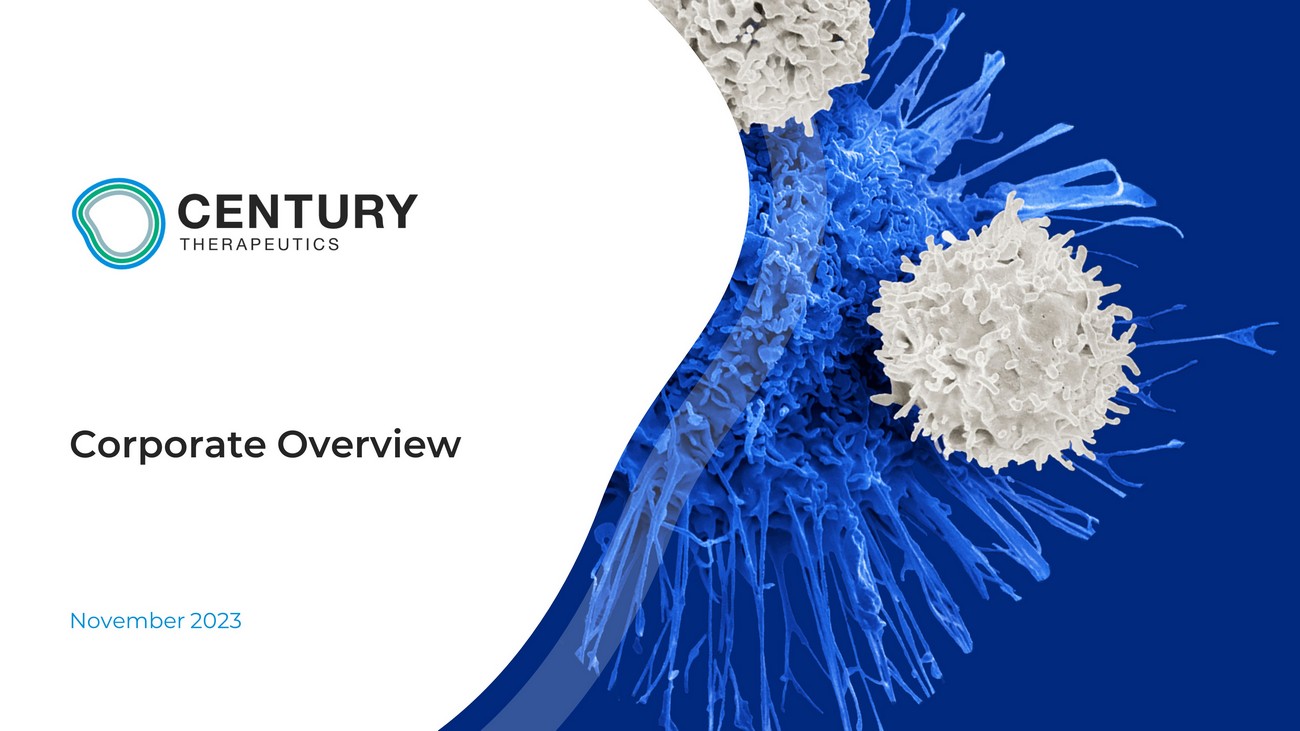
Corporate Overview November 2023
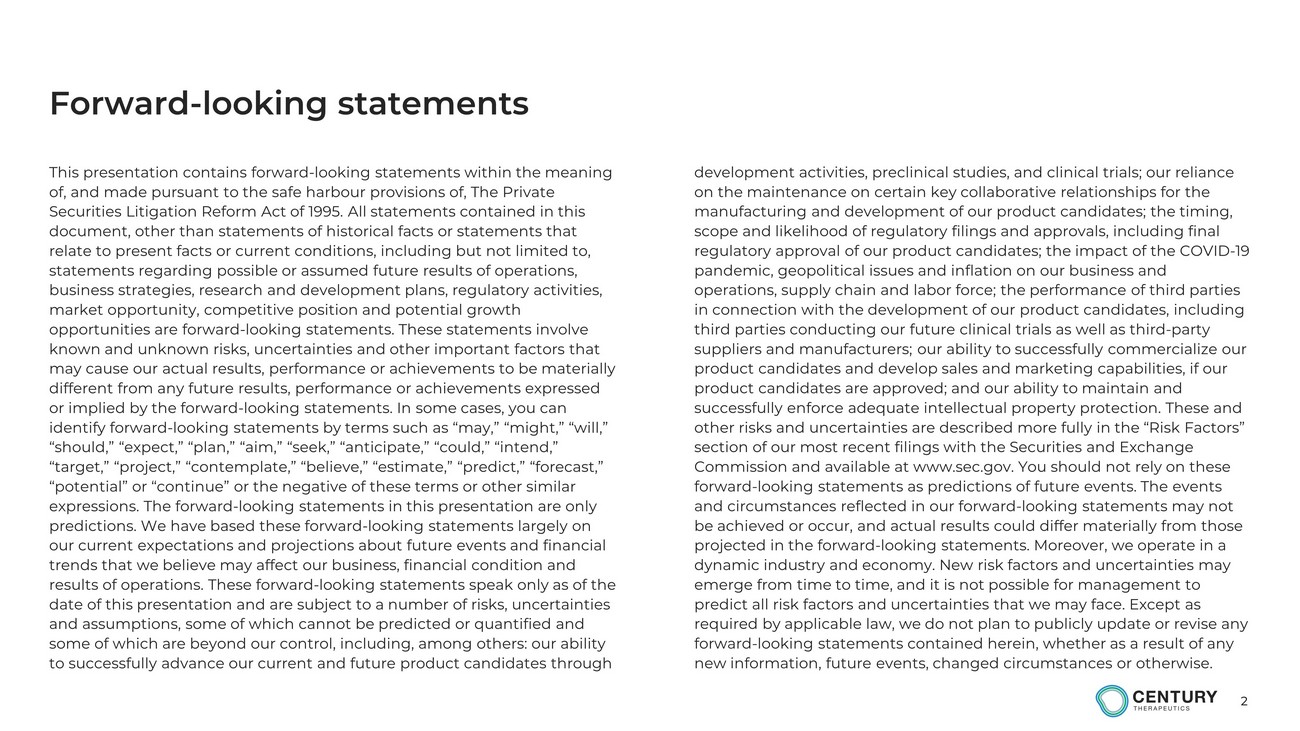
2 Forward - looking statements This presentation contains forward - looking statements within the meaning of, and made pursuant to the safe harbour provisions of, The Private Securities Litigation Reform Act of 1995. All statements contained in this document, other than statements of historical facts or statements that relate to present facts or current conditions, including but not limited to, statements regarding possible or assumed future results of operations, business strategies, research and development plans, regulatory activities, market opportunity, competitive position and potential growth opportunities are forward - looking statements. These statements involve known and unknown risks, uncertainties and other important factors that may cause our actual results, performance or achievements to be materially different from any future results, performance or achievements expressed or implied by the forward - looking statements. In some cases, you can identify forward - looking statements by terms such as “may,” “might,” “will,” “should,” “expect,” “plan,” “aim,” “seek,” “anticipate,” “could,” “intend,” “target,” “project,” “contemplate,” “believe,” “estimate,” “predict,” “forecast,” “potential” or “continue” or the negative of these terms or other similar expressions. The forward - looking statements in this presentation are only predictions. We have based these forward - looking statements largely on our current expectations and projections about future events and financial trends that we believe may affect our business, financial condition and results of operations. These forward - looking statements speak only as of the date of this presentation and are subject to a number of risks, uncertainties and assumptions, some of which cannot be predicted or quantified and some of which are beyond our control, including, among others: our ability to successfully advance our current and future product candidates through development activities, preclinical studies, and clinical trials; our reliance on the maintenance on certain key collaborative relationships for the manufacturing and development of our product candidates; the timing, scope and likelihood of regulatory filings and approvals, including final regulatory approval of our product candidates; the impact of the COVID - 19 pandemic, geopolitical issues and inflation on our business and operations, supply chain and labor force; the performance of third parties in connection with the development of our product candidates, including third parties conducting our future clinical trials as well as third - party suppliers and manufacturers; our ability to successfully commercialize our product candidates and develop sales and marketing capabilities, if our product candidates are approved; and our ability to maintain and successfully enforce adequate intellectual property protection. These and other risks and uncertainties are described more fully in the “Risk Factors” section of our most recent filings with the Securities and Exchange Commission and available at www.sec.gov. You should not rely on these forward - looking statements as predictions of future events. The events and circumstances reflected in our forward - looking statements may not be achieved or occur, and actual results could differ materially from those projected in the forward - looking statements. Moreover, we operate in a dynamic industry and economy. New risk factors and uncertainties may emerge from time to time, and it is not possible for management to predict all risk factors and uncertainties that we may face. Except as required by applicable law, we do not plan to publicly update or revise any forward - looking statements contained herein, whether as a result of any new information, future events, changed circumstances or otherwise.

3 Investment thesis Next generation platforms for iNK and gamma delta iT candidates Foundational investments in iPSC technology, genetic editing, and manufacturing Experienced team in R&D, immuno - oncology, manufacturing and commercialization Exemplified by execution of ongoing first - in - human Phase 1 ELiPSE - 1 trial Well capitalized with cash runway into 2026 $284.3M in cash, cash equivalents and investments at the end of 3Q23; operational efficiencies designed to enable delivery on key milestones, clinical data
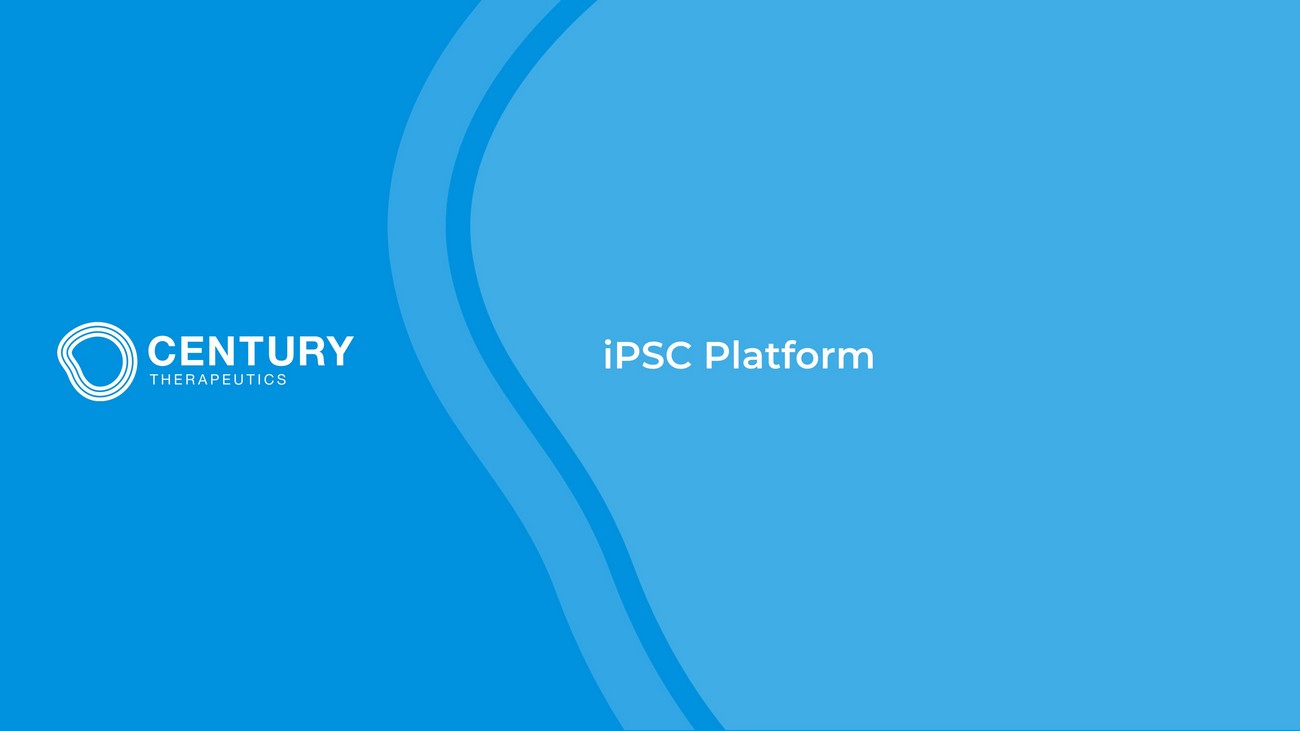
iPSC Platform
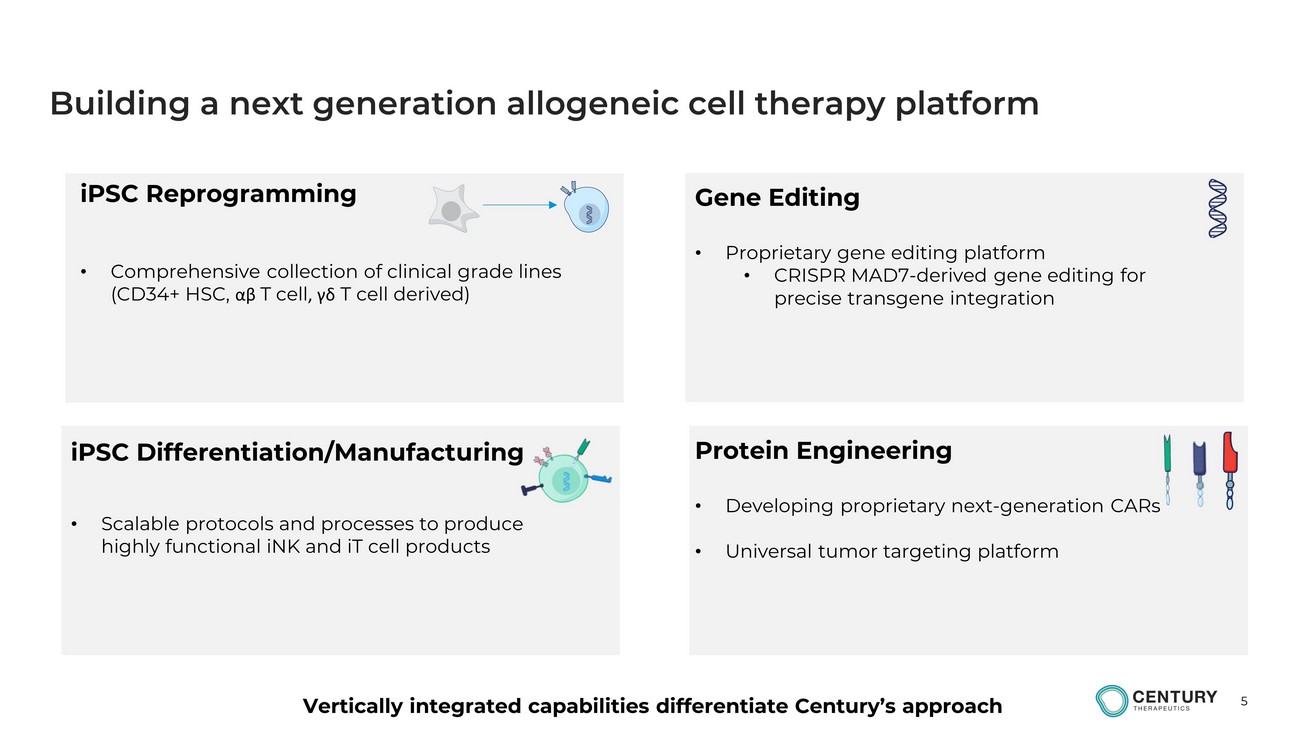
5 Building a next generation allogeneic cell therapy platform Gene Editing • Proprietary gene editing platform • CRISPR MAD7 - derived gene editing for precise transgene integration Protein Engineering • Developing proprietary next - generation CARs • Universal tumor targeting platform iPSC Differentiation/Manufacturing • Scalable protocols and processes to produce highly functional iNK and iT cell products iPSC Reprogramming • Comprehensive collection of clinical grade lines (CD34+ HSC, αβ T cell , γδ T cell derived) Vertically integrated capabilities differentiate Century’s approach
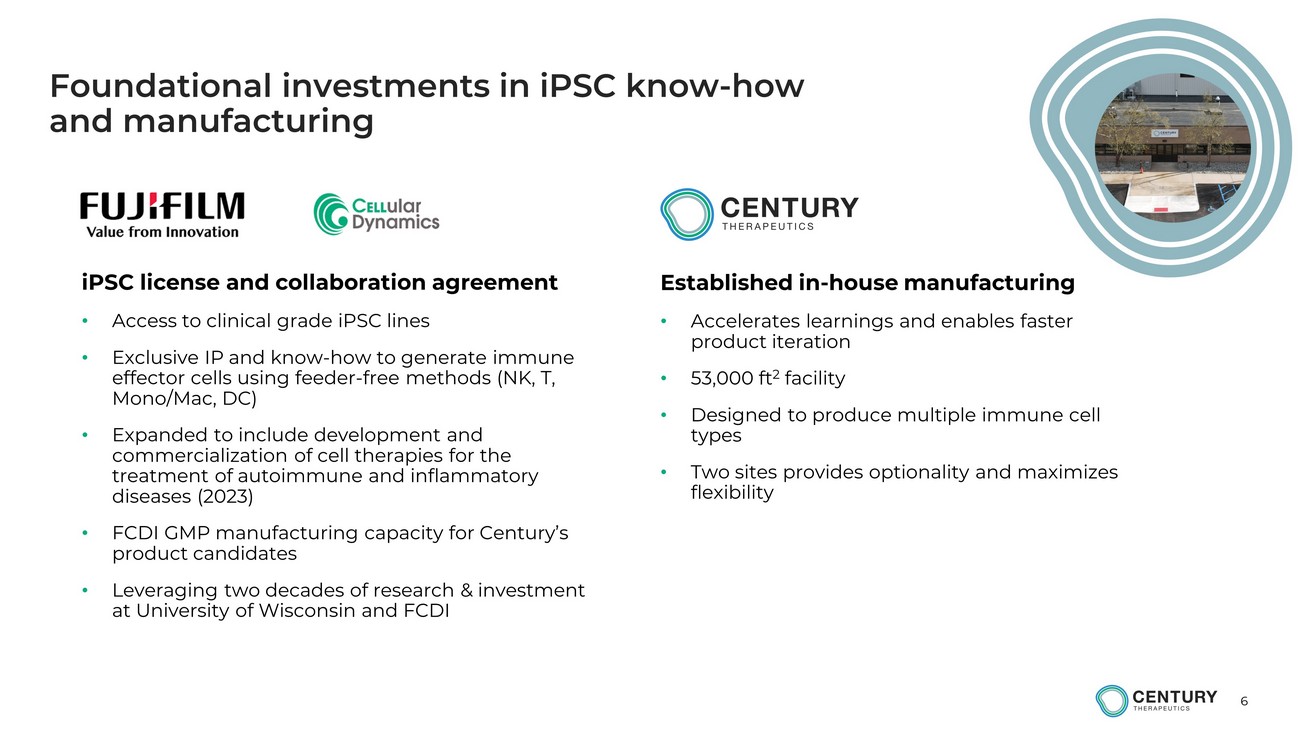
6 Foundational investments in iPSC know - how and manufacturing Established in - house manufacturing • Accelerates learnings and enables faster product iteration • 53,000 ft 2 facility • Designed to produce multiple immune cell types • Two sites provides optionality and maximizes flexibility iPSC license and collaboration agreement • Access to clinical grade iPSC lines • Exclusive IP and know - how to generate immune effector cells using feeder - free methods (NK, T, Mono/ Mac, DC) • Expanded to include development and commercialization of cell therapies for the treatment of autoimmune and inflammatory diseases (2023) • FCDI GMP manufacturing capacity for Century’s product candidates • Leveraging two decades of research & investment at University of Wisconsin and FCDI
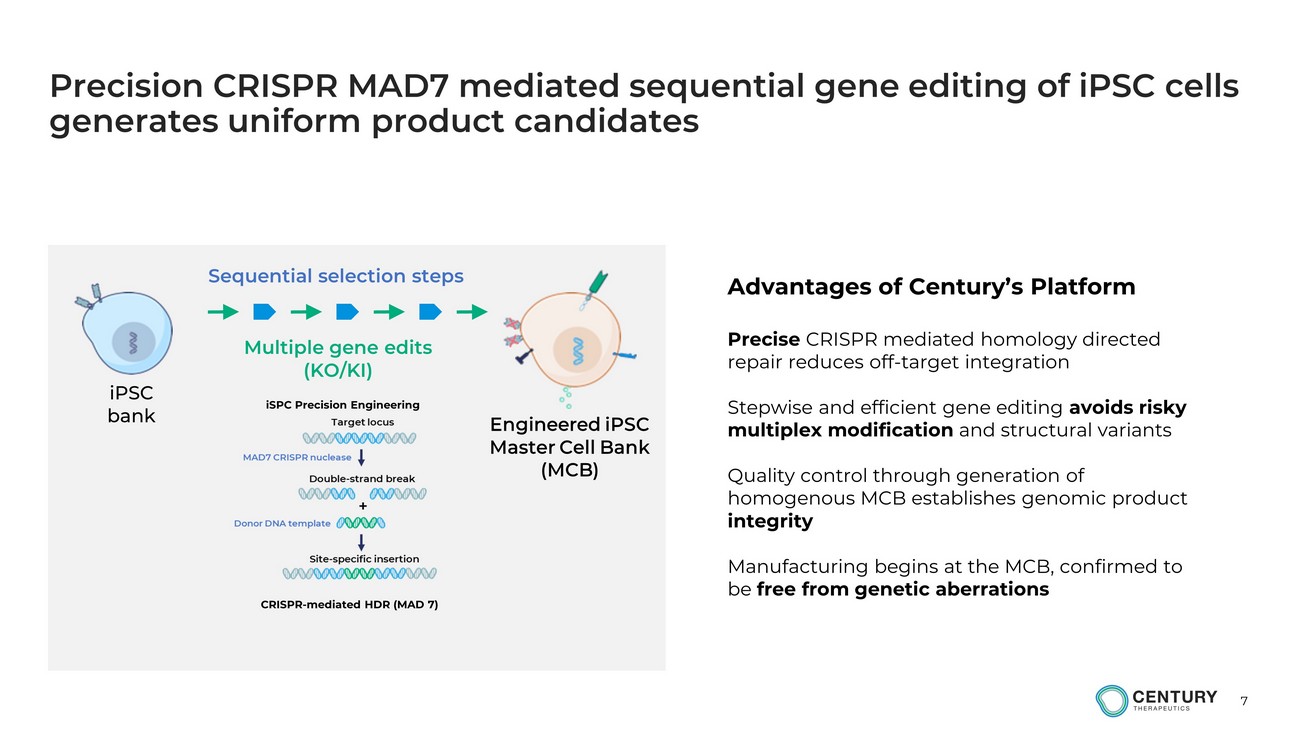
7 Multiple gene edits (KO/KI) iPSC bank Precision CRISPR MAD7 mediated sequential gene editing of iPSC cells generates uniform product candidates Engineered iPSC Master Cell Bank (MCB) Advantages of Century’s Platform P recise CRISPR mediated homology directed repair reduces off - target integration Stepwise and efficient gene editing avoids risky multiplex modification and structural variants Quality control through generation of homogenous MCB establishes genomic product integrity Manufacturing begins at the MCB, confirmed to be free from genetic aberrations Sequential selection steps iSPC Precision Engineering CRISPR - mediated HDR (MAD 7)
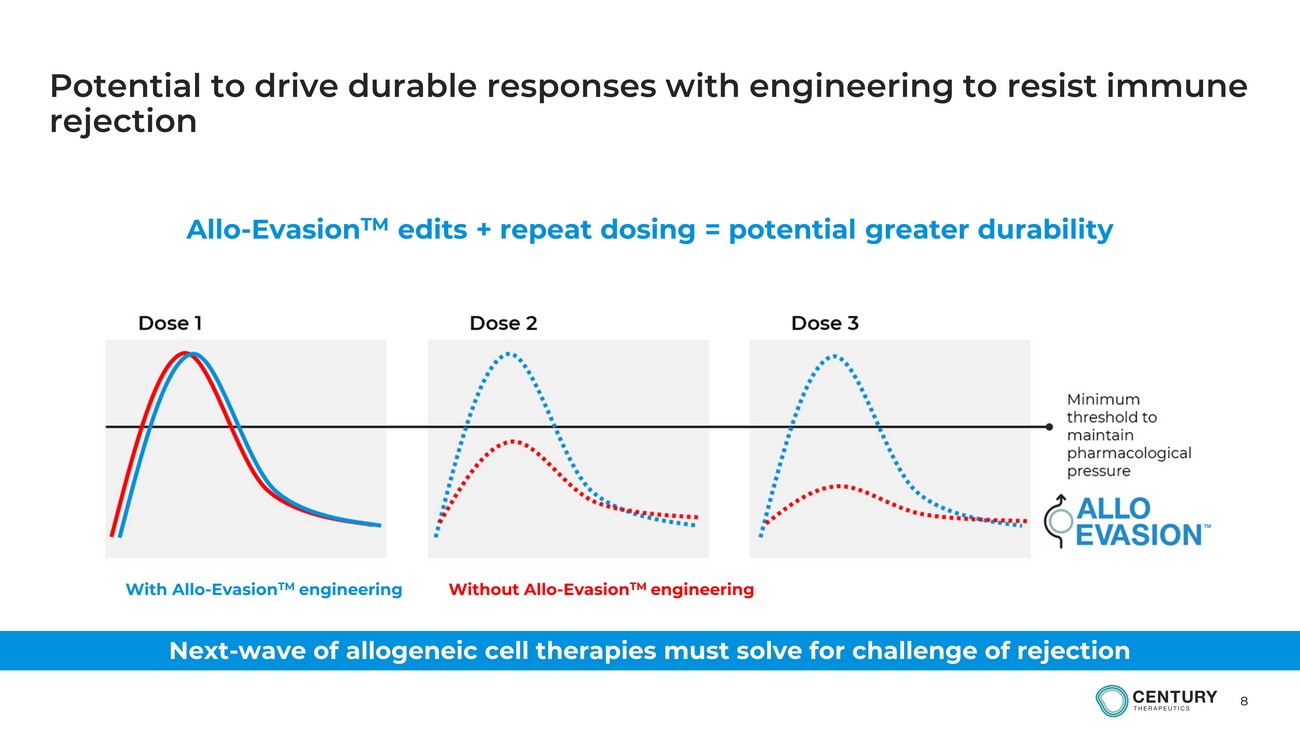
8 Potential to drive durable responses with engineering to resist immune rejection Allo - Evasion TM edits + repeat dosing = potential greater durability Next - wave of allogeneic cell therapies must solve for challenge of rejection With Allo - Evasion TM engineering Without Allo - Evasion TM engineering
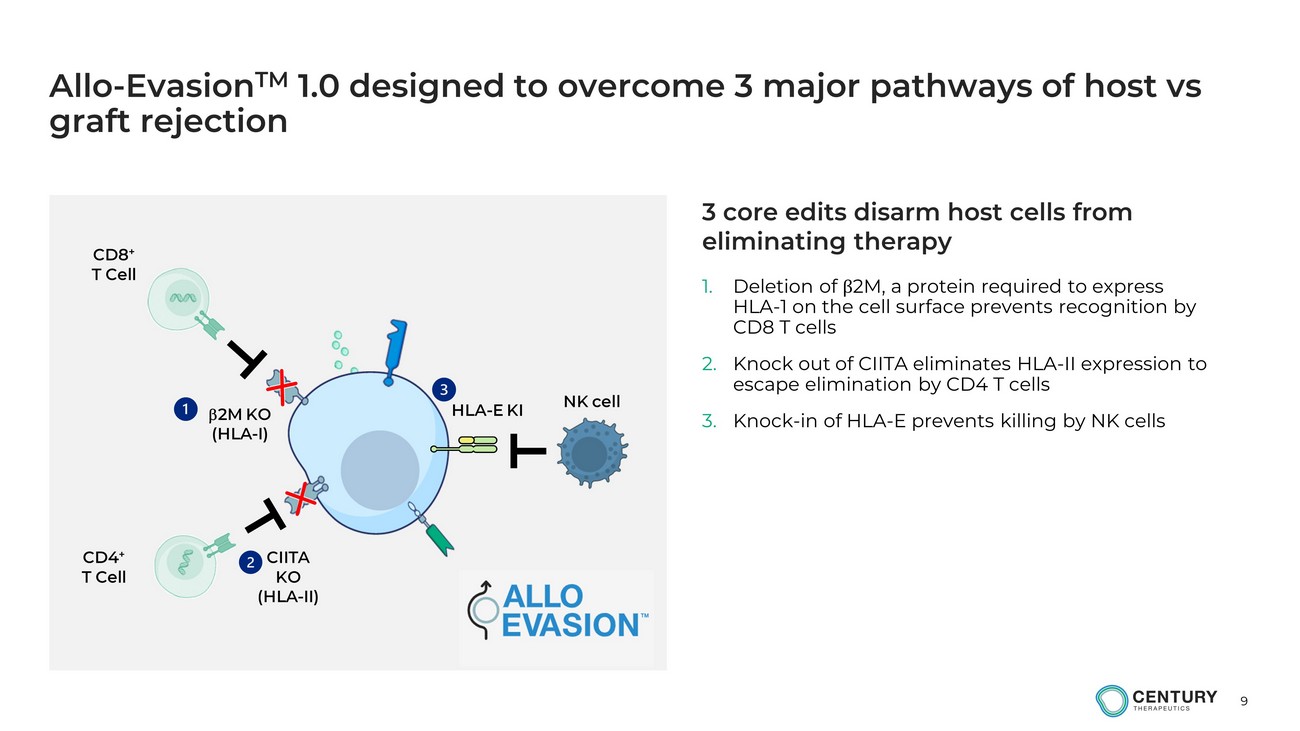
9 Allo - Evasion TM 1.0 designed to overcome 3 major pathways of host vs graft rejection 1. Deletion of β 2M, a protein required to express HLA - 1 on the cell surface prevents recognition by CD8 T cells 2. Knock out of CIITA eliminates HLA - II expression to escape elimination by CD4 T cells 3. Knock - in of HLA - E prevents killing by NK cells b 2M KO (HLA - I) HLA - E KI CIITA KO (HLA - II) CD8 + T Cell CD4 + T Cell NK cell 3 core edits disarm host cells from eliminating therapy
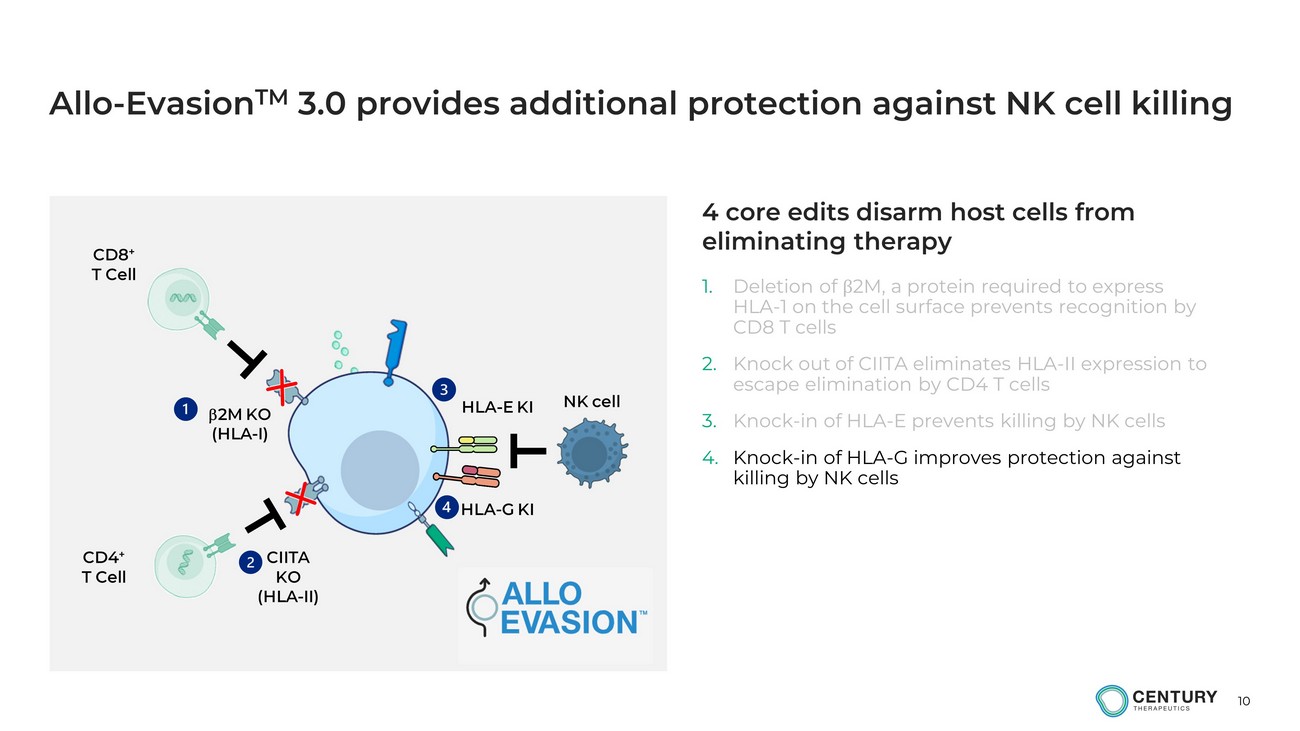
10 Allo - Evasion TM 3.0 provides additional protection against NK cell killing 1. Deletion of β 2M, a protein required to express HLA - 1 on the cell surface prevents recognition by CD8 T cells 2. Knock out of CIITA eliminates HLA - II expression to escape elimination by CD4 T cells 3. Knock - in of HLA - E prevents killing by NK cells 4. Knock - in of HLA - G improves protection against killing by NK cells b 2M KO (HLA - I) HLA - E KI CIITA KO (HLA - II) CD8 + T Cell CD4 + T Cell NK cell 4 core edits disarm host cells from eliminating therapy HLA - G KI
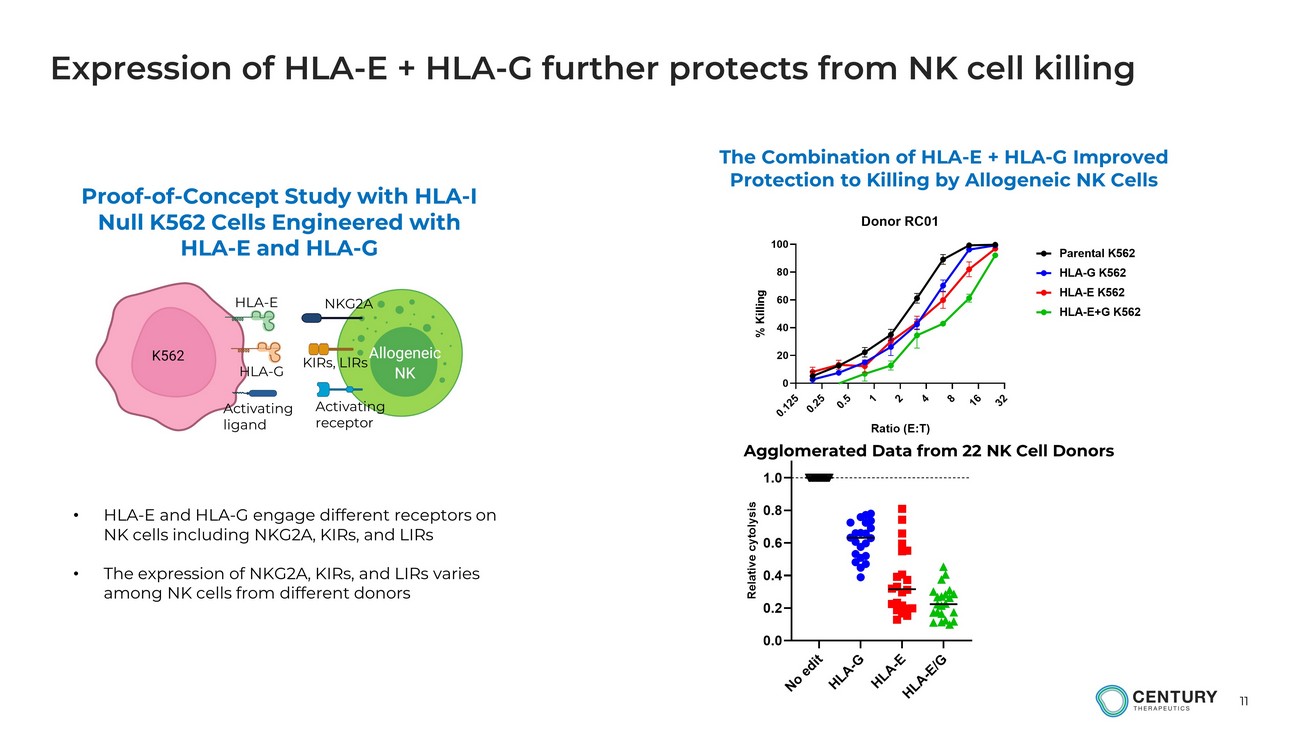
11 Expression of HLA - E + HLA - G further protects from NK cell killing HLA - E HLA - G NKG2A KIRs, LIRs Activating ligand Activating receptor Proof - of - Concept Study with HLA - I Null K562 Cells Engineered with HLA - E and HLA - G 0 . 1 2 5 0 . 2 5 0 . 5 1 2 4 8 1 6 3 2 0 20 40 60 80 100 Donor RC01 Ratio (E:T) % K i l l i n g Parental K562 HLA-G K562 HLA-E K562 HLA-E+G K562 The Combination of HLA - E + HLA - G Improved Protection to Killing by Allogeneic NK Cells • HLA - E and HLA - G engage different receptors on NK cells including NKG2A, KIRs, and LIRs • The expression of NKG2A, KIRs, and LIRs varies among NK cells from different donors Agglomerated Data from 22 NK Cell Donors N o e d i t H L A - G H L A - E H L A - E / G 0.0 0.2 0.4 0.6 0.8 1.0 R e l a t i v e c y t o l y s i s
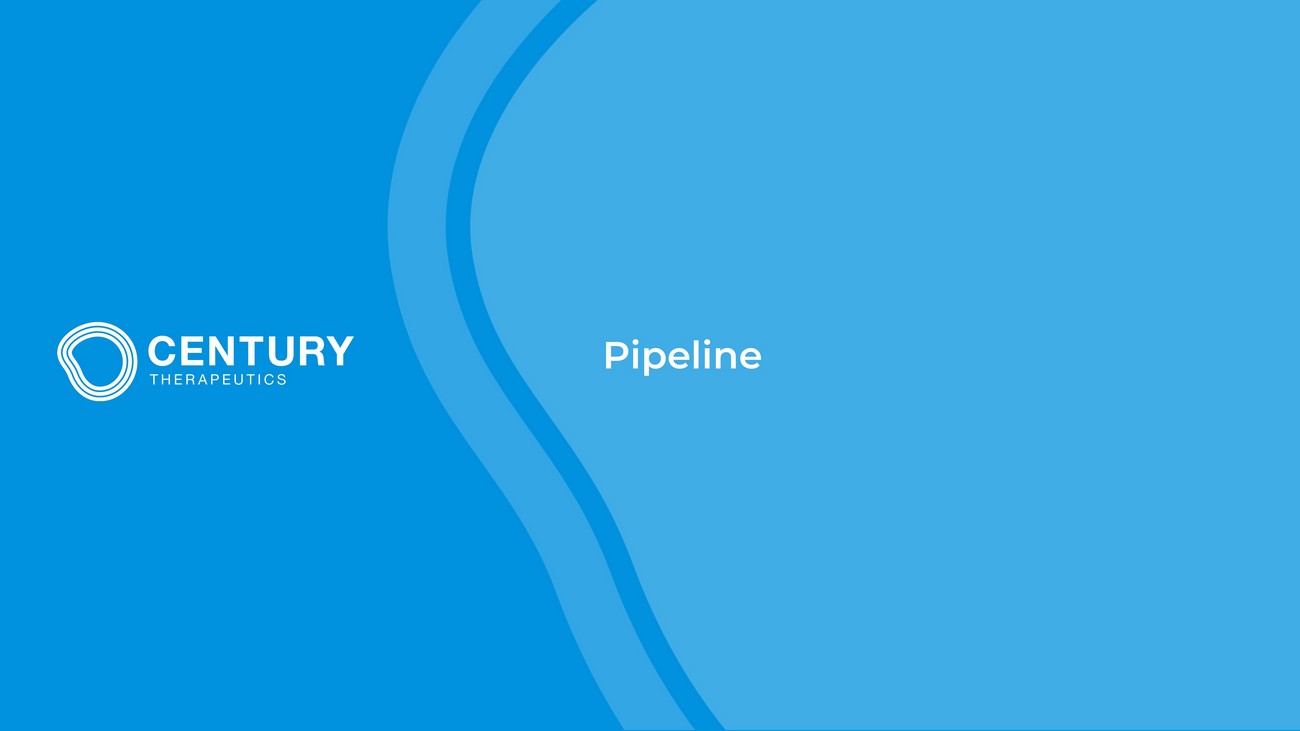
Pipeline
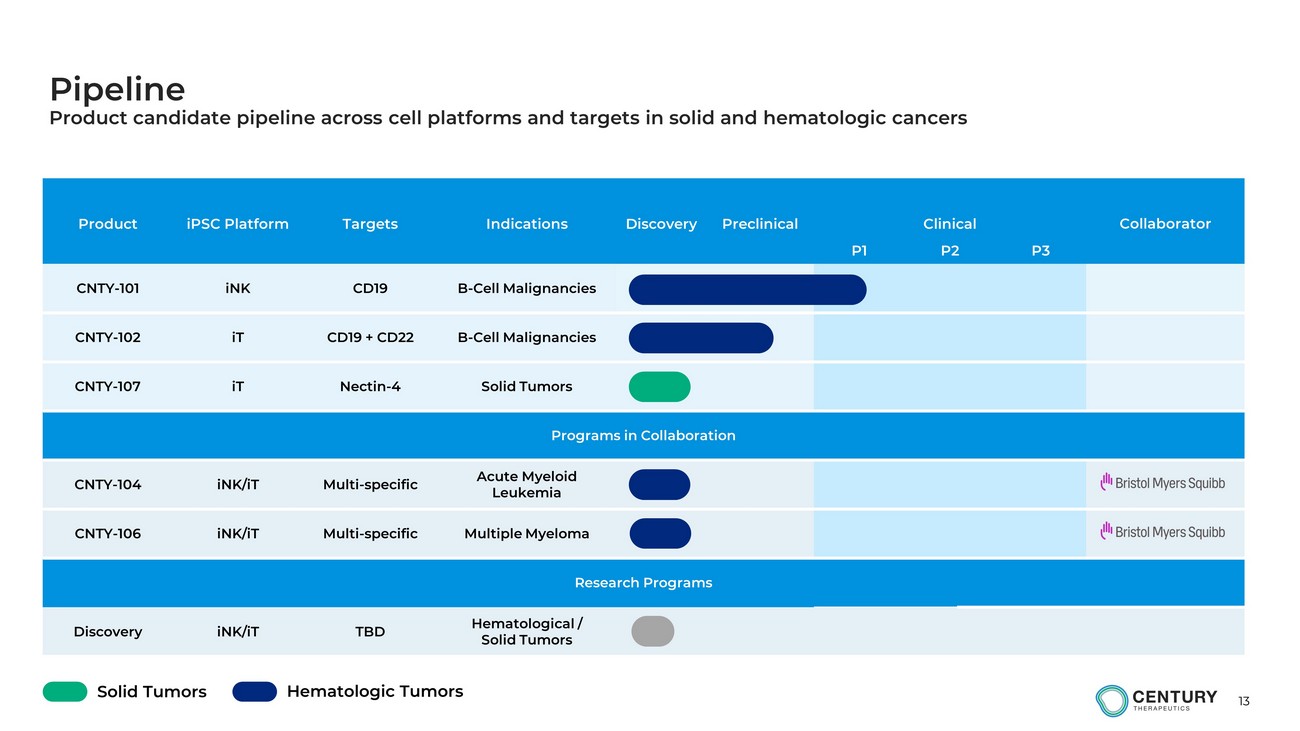
13 Product iPSC Platform Targets Indications Discovery Preclinical Clinical Collaborator P1 P2 P3 CNTY - 101 iNK CD19 B - Cell Malignancies CNTY - 102 iT CD19 + CD22 B - Cell Malignancies CNTY - 107 iT Nectin - 4 Solid Tumors Programs in Collaboration CNTY - 104 iNK/iT Multi - specific Acute Myeloid Leukemia CNTY - 106 iNK/iT Multi - specific Multiple Myeloma Research Programs Discovery iNK/iT TBD Hematological / Solid Tumors Pipeline Product candidate pipeline across cell platforms and targets in solid and hematologic cancers Hematologic Tumors Solid Tumors
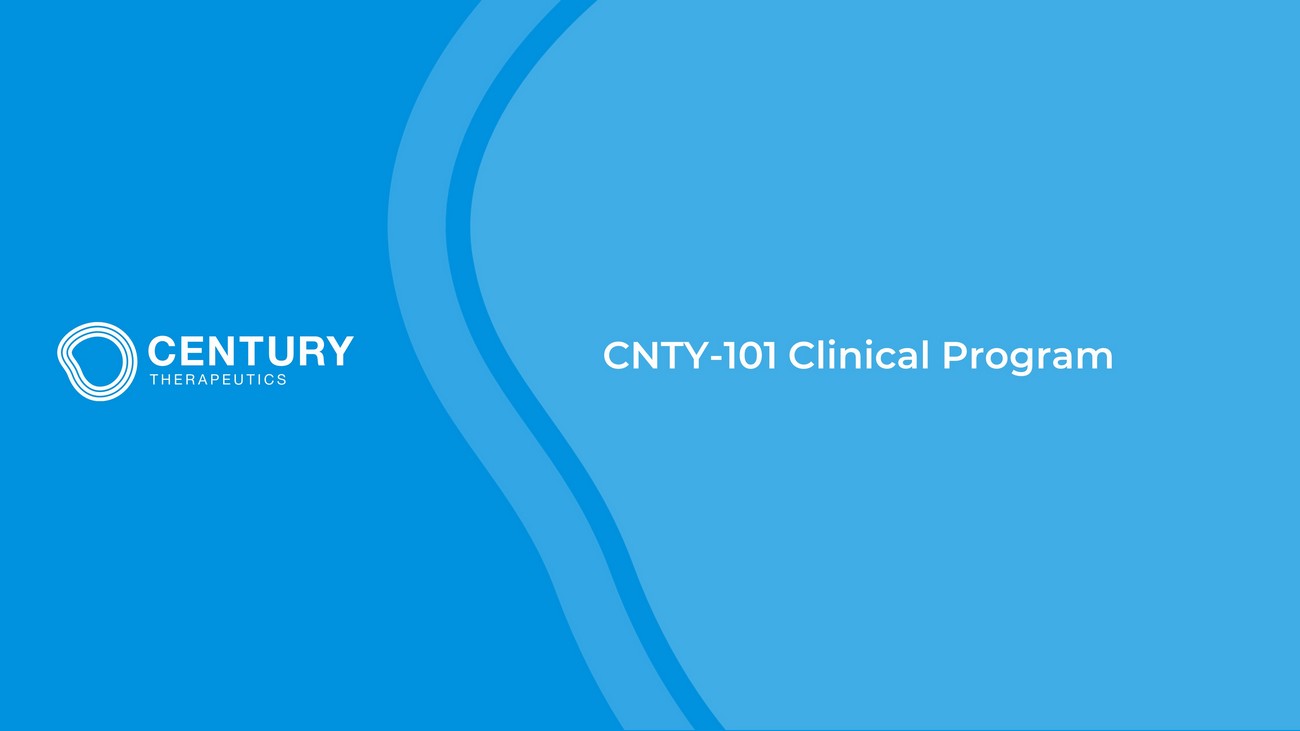
CNTY - 101 Clinical Program
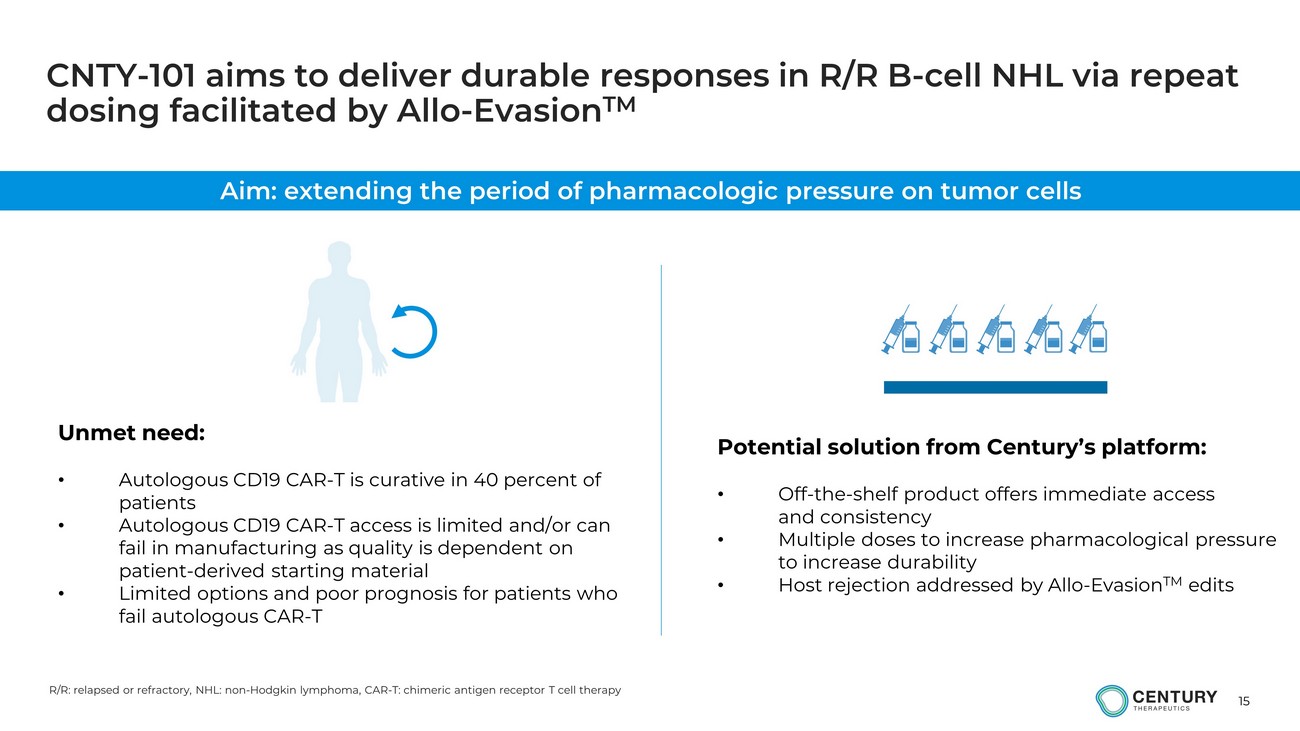
15 CNTY - 101 aims to deliver durable responses in R/R B - cell NHL via repeat dosing facilitated by Allo - Evasion TM R/R: relapsed or refractory, NHL: non - Hodgkin lymphoma, CAR - T: chimeric antigen receptor T cell therapy Potential solution from Century’s platform: • Off - the - shelf product offers immediate access and consistency • Multiple doses to increase pharmacological pressure to increase durability • Host rejection addressed by Allo - Evasion TM edits Unmet need: • Autologous CD19 CAR - T is curative in 40 percent of patients • Autologous CD19 CAR - T access is limited and/or can fail in manufacturing as quality is dependent on patient - derived starting material • Limited options and poor prognosis for patients who fail autologous CAR - T Aim: extending the period of pharmacologic pressure on tumor cells
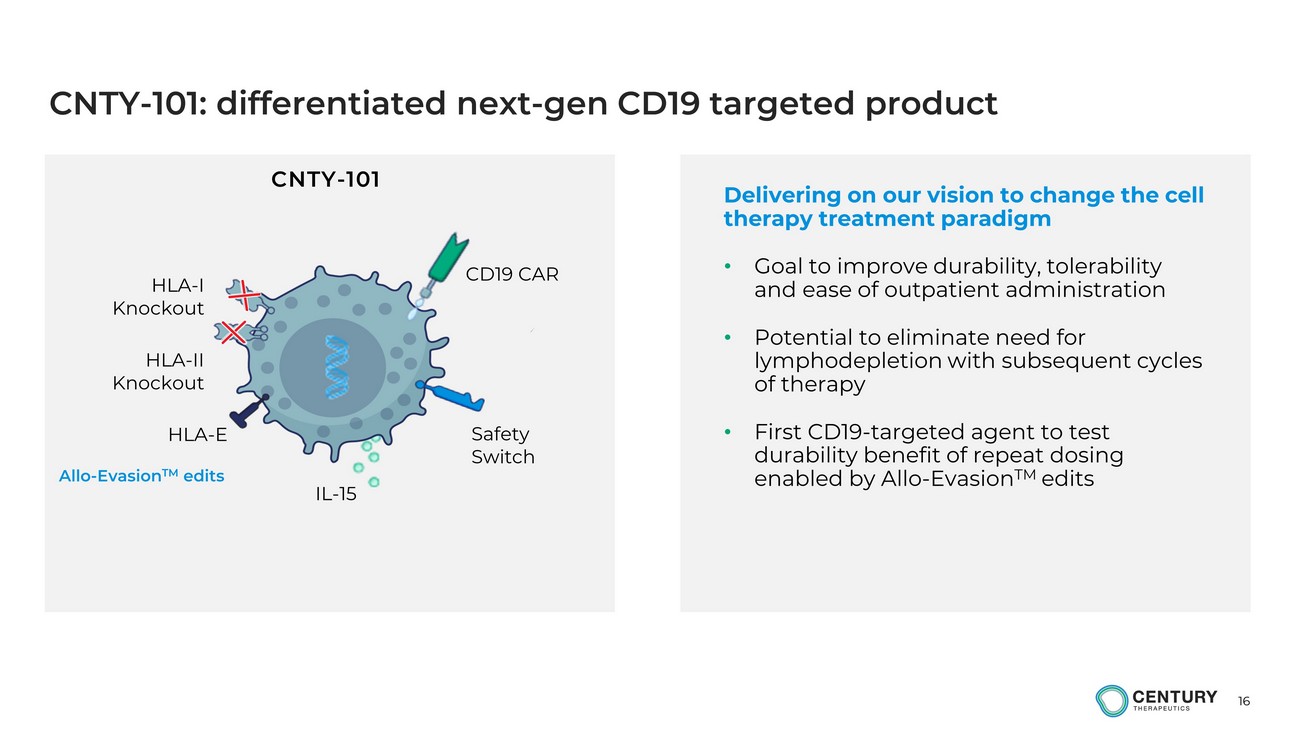
16 Delivering on our vision to change the cell therapy treatment paradigm • Goal to improve durability, tolerability and ease of outpatient administration • Potential to e liminate need for lymphodepletion with subsequent cycles of therapy • First CD19 - targeted agent to test durability benefit of repeat dosing enabled by Allo - Evasion TM edits CNTY - 101: differentiated next - gen CD19 targeted product CNTY - 101 Allo - Evasion TM edits HLA - I Knockout IL - 15 HLA - II Knockout CD19 CAR HLA - E Safety Switch
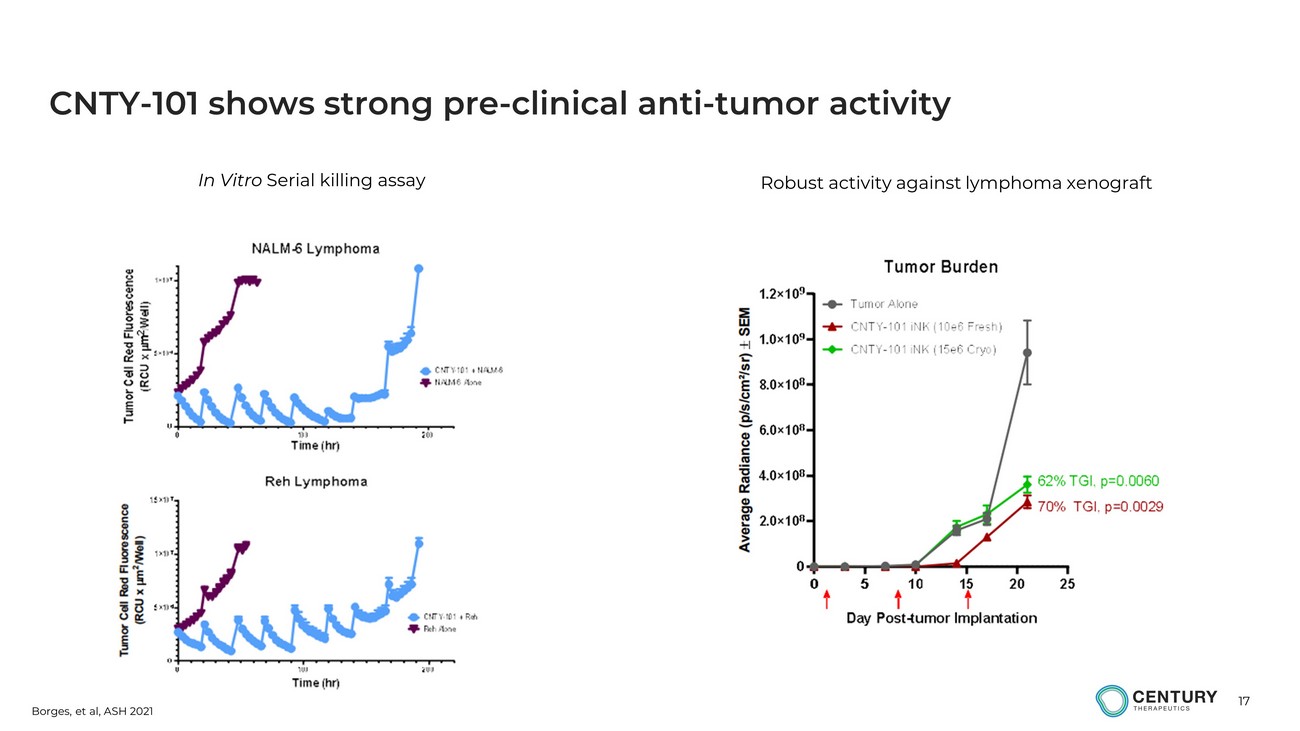
17 CNTY - 101 shows strong pre - clinical anti - tumor activity In Vitro Serial killing assay Robust activity against lymphoma xenograft Borges, et al, ASH 202 1

18 CNTY - 101: ELiPSE - 1 (NCT05336409) Phase 1 BOIN 1 Design Initial clinical data to be presented at ASH 2023 Annual Meeting in December Clinical data providing initial proof - of - concept expected in 2024 1 BOIN: Bayesian Optimal Interval 2 Standard lymphodepletion regimen: fludarabine (30 mg/m2/d) and cyclophosphamide IV (300 mg/m2/d) for 3 days 3 Subjects who are assessed as stable disease or better may receive additional cycles of CNTY - 101 Patients with CD19+ aggressive and high - risk indolent R/R B - NHL ▪ DLBCL, HGBL, MCL, PMBCL, FL3B, FL, MZL ▪ ≥ 2 prior lines of therapy ▪ Prior CD19 - targeted cell therapy allowed Part 1 - Schedule A: single dose escalation Schedule B: 1 dose per week x 3 weeks Part 2 - Dose expansion Initial Dose Additional Cycles 3 First Additional Cycle: lymphodepletion at investigator discretion No lymphodepletion for following cycles Schedule A Dose level 1: 100 x 10 6 Dose level 2: 300 x 10 6 Dose level 3: 1000 x 10 6 LYMPHO - DEPLETION 2 IL - 2 x 22 days Schedule B Dose level 2: 300 x 10 6 x3 Dose level 3: 1000 x 10 6 x3 28 - DAY DLT PERIOD RESPONSE ASSESSMENT Patient enrollment CNTY - 101 DAY 1 101 DAY 1 DAY 8 101 101 DAY 15 101 DAY 1 101 DAY 1 DAY 8 101 101 DAY 15 IL - 2 x 8 days IL - 2 x 8 days IL - 2 x 22 days
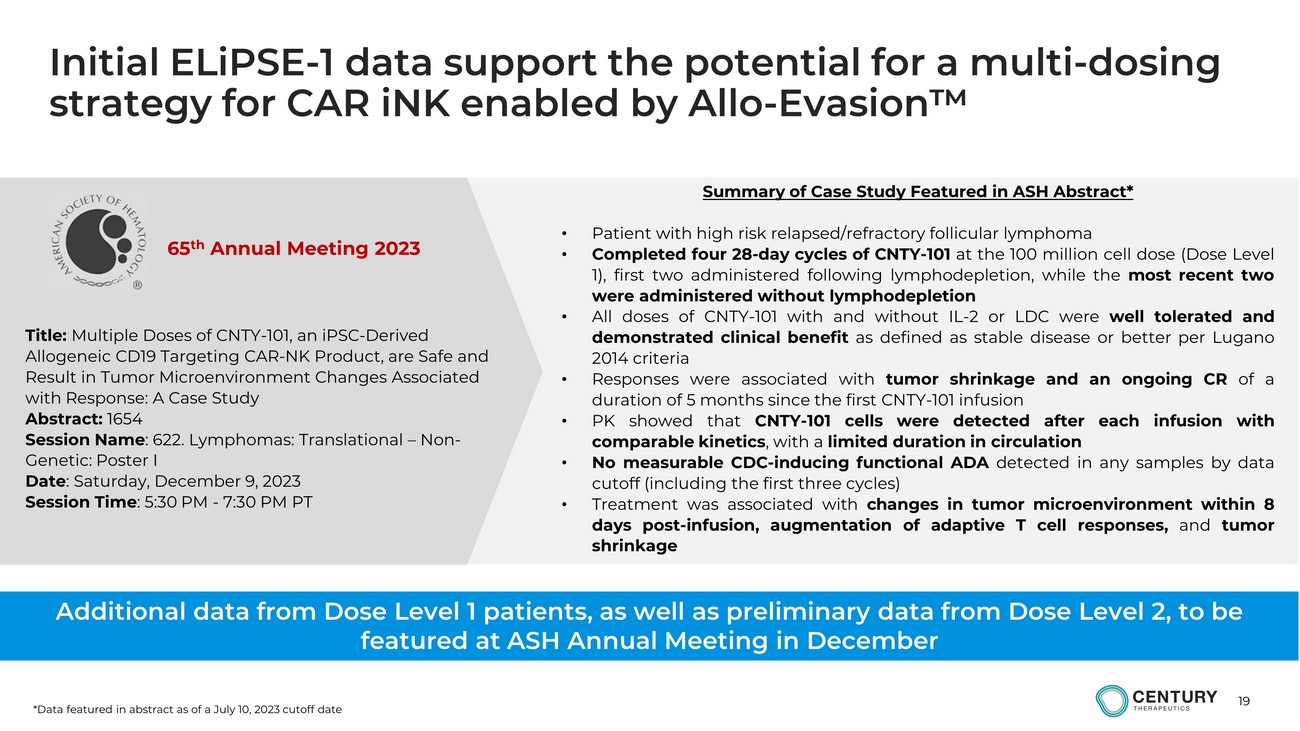
19 Initial ELiPSE - 1 data support the potential for a multi - dosing strategy for CAR iNK enabled by Allo - Evasion ۲ 65 th Annual Meeting 2023 Title: Multiple Doses of CNTY - 101, an iPSC - Derived Allogeneic CD19 Targeting CAR - NK Product, are Safe and Result in Tumor Microenvironment Changes Associated with Response: A Case Study Abstract: 1654 Session Name : 622. Lymphomas: Translational – Non - Genetic: Poster I Date : Saturday, December 9, 2023 Session Time : 5:30 PM - 7:30 PM PT Summary of Case Study Featured in ASH Abstract* • Patient with high risk relapsed/refractory follicular lymphoma • Completed four 28 - day cycles of CNTY - 101 at the 100 million cell dose (Dose Level 1 ), first two administered following lymphodepletion, while the most recent two were administered without lymphodepletion • All doses of CNTY - 101 with and without IL - 2 or LDC were well tolerated and demonstrated clinical benefit as defined as stable disease or better per Lugano 2014 criteria • Responses were associated with tumor shrinkage and an ongoing CR of a duration of 5 months since the first CNTY - 101 infusion • PK showed that CNTY - 101 cells were detected after each infusion with comparable kinetics , with a limited duration in circulation • No measurable CDC - inducing functional ADA detected in any samples by data cutoff (including the first three cycles) • T reatment was associated with changes in tumor microenvironment within 8 days post - infusion, augmentation of adaptive T cell responses, and tumor shrinkage *Data featured in abstract as of a July 10, 2023 cutoff date Additional data from Dose Level 1 patients, as well as preliminary data from Dose Level 2, to be featured at ASH Annual Meeting in December
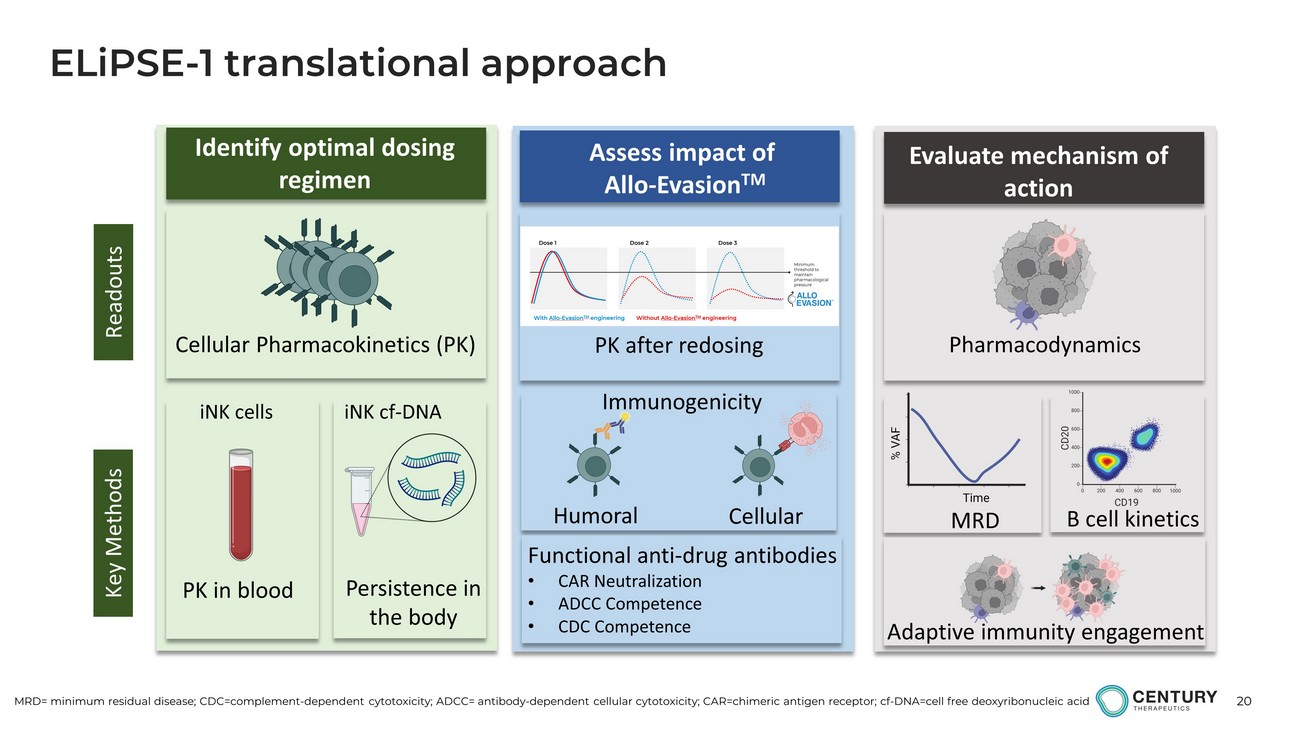
20 ELiPSE - 1 translational approach MRD= minimum residual disease; CDC=complement - dependent cytotoxicity; ADCC= antibody - dependent cellular cytotoxicity; CAR=chimer ic antigen receptor; cf - DNA=cell free deoxyribonucleic acid Identify optimal dosing regimen Cellular Pharmacokinetics (PK) Assess impact of Allo - Evasion TM PK after redosing Humoral Cellular Functional anti - drug antibodies • CAR Neutralization • ADCC Competence • CDC Competence Evaluate mechanism of action PK in blood Persistence in the body Pharmacodynamics B cell kinetics MRD Adaptive immunity engagement iNK cf - DNA Key Methods Readouts iNK cells Immunogenicity
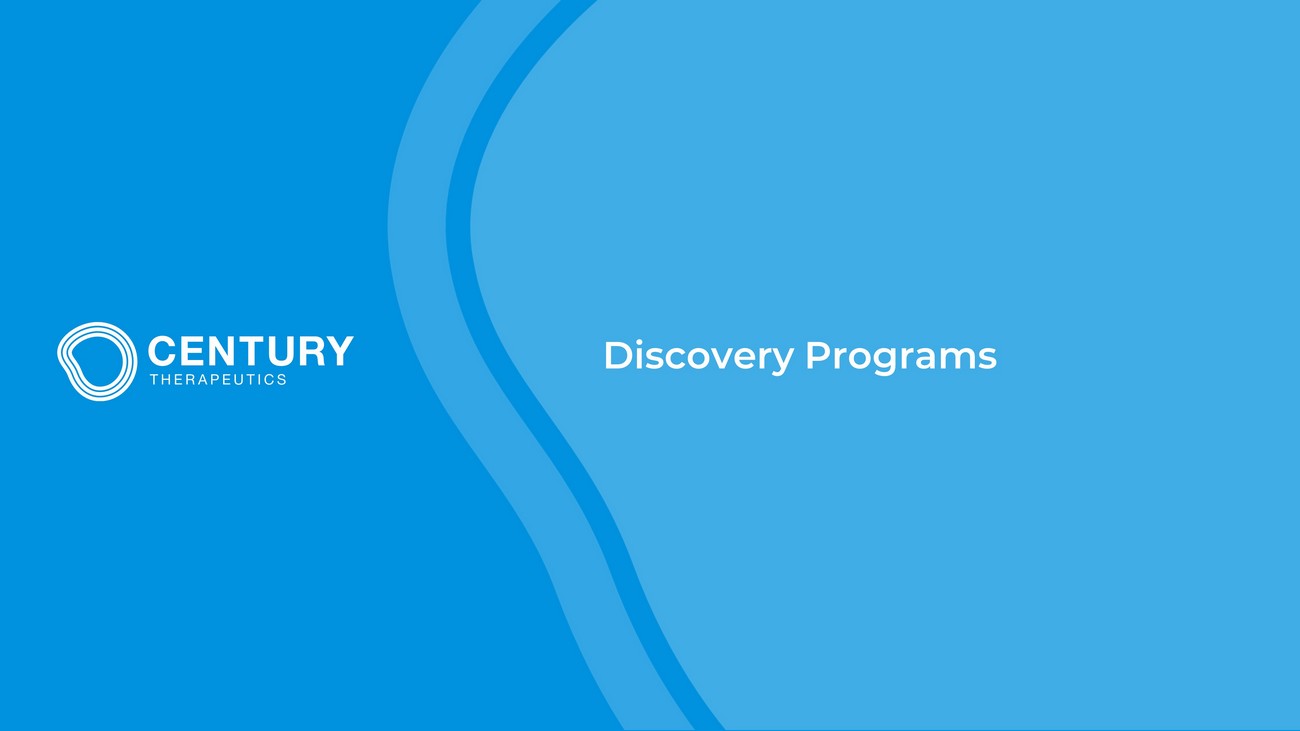
Discovery Programs
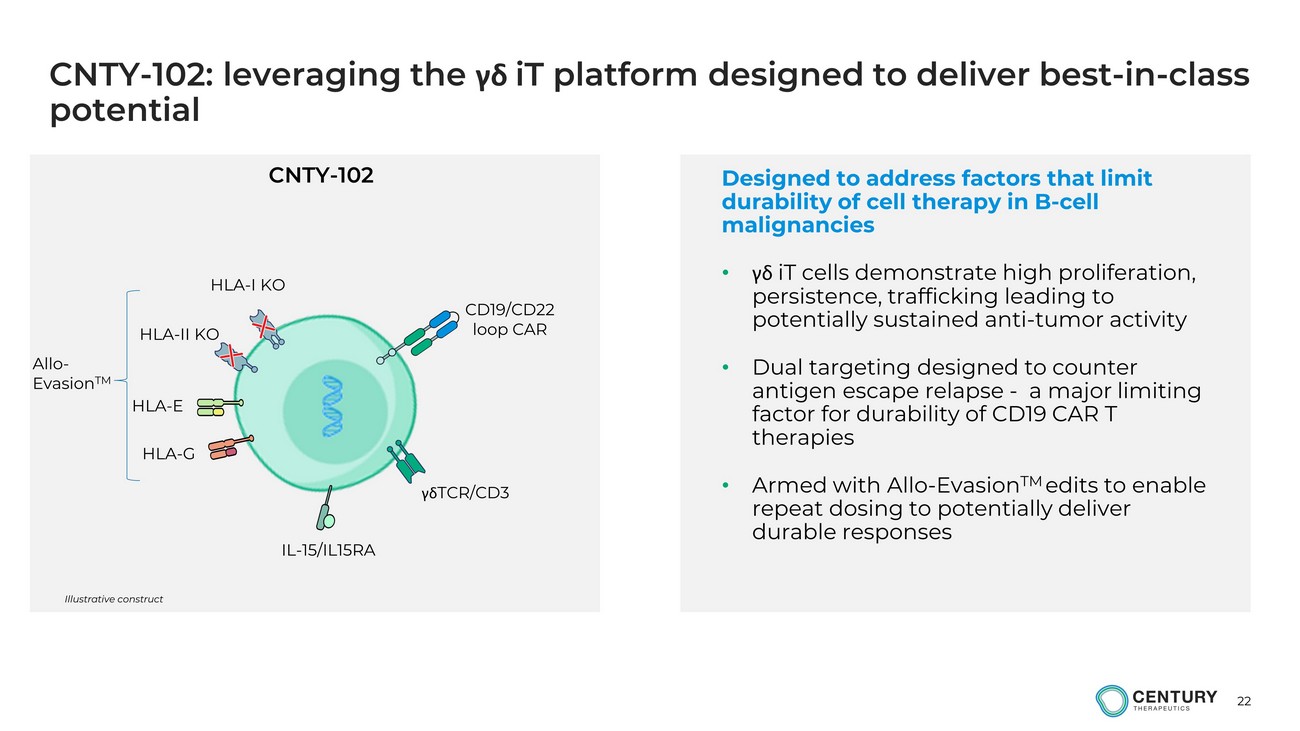
22 CNTY - 102: leveraging the γδ iT platform designed to deliver best - in - class potential HLA - II KO Illustrative construct γδ TCR/CD3 IL - 15/IL15RA HLA - E HLA - G HLA - I KO CD19/CD22 loop CAR Designed to address factors that limit durability of cell therapy in B - cell malignancies • γδ iT cells demonstrate high proliferation, persistence, trafficking leading to potentially sustained anti - tumor activity • Dual targeting designed to counter antigen escape relapse - a major limiting factor for durability of CD19 CAR T therapies • Armed with Allo - Evasion TM edits to enable repeat dosing to potentially deliver durable responses CNTY - 102 Allo - Evasion TM
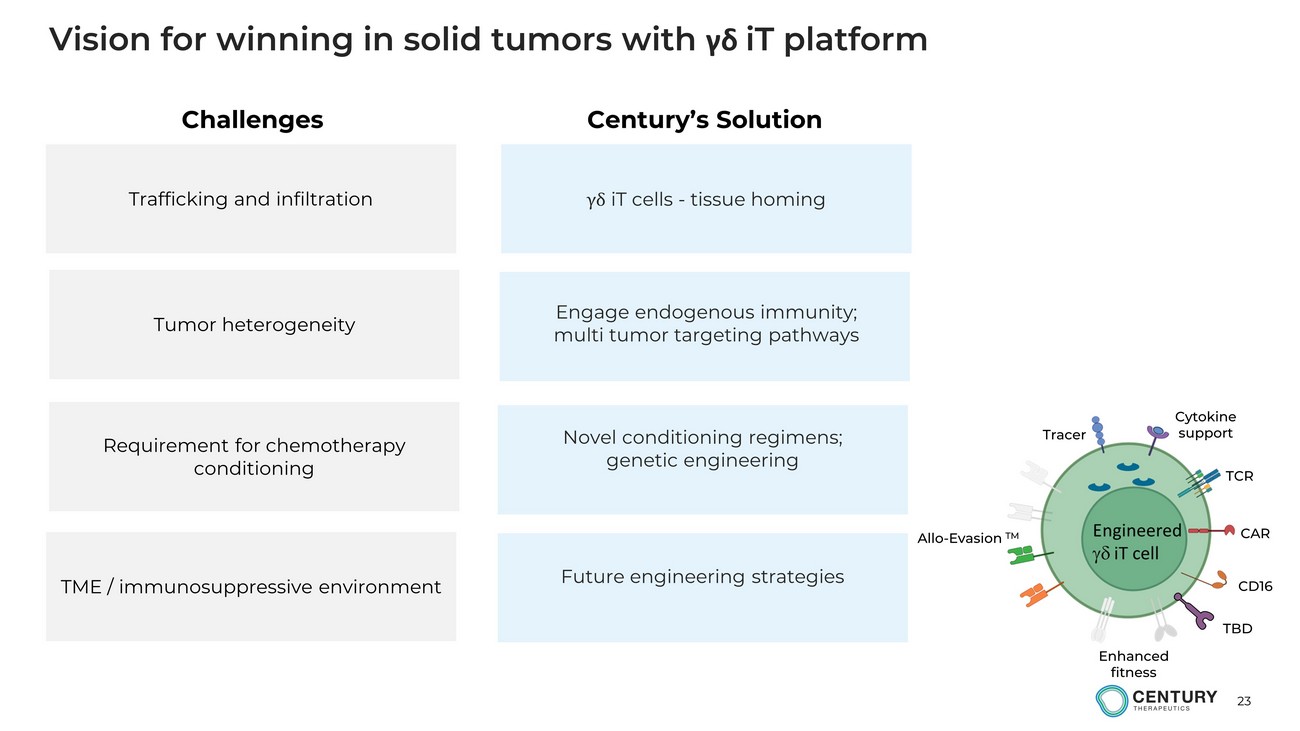
23 Vision for winning in solid tumors with γδ iT platform Trafficking and infiltration γδ iT cells - tissue homing TME / immunosuppressive environment Requirement for chemotherapy conditioning Tumor heterogeneity Novel conditioning regimens; g enetic engineering Challenges Century’s Solution Future engineering strategies Engage endogenous immunity; m ulti tumor targeting pathways CAR CD16 TCR Cytokine support Allo - Evasion TM Enhanced fitness Tracer TBD
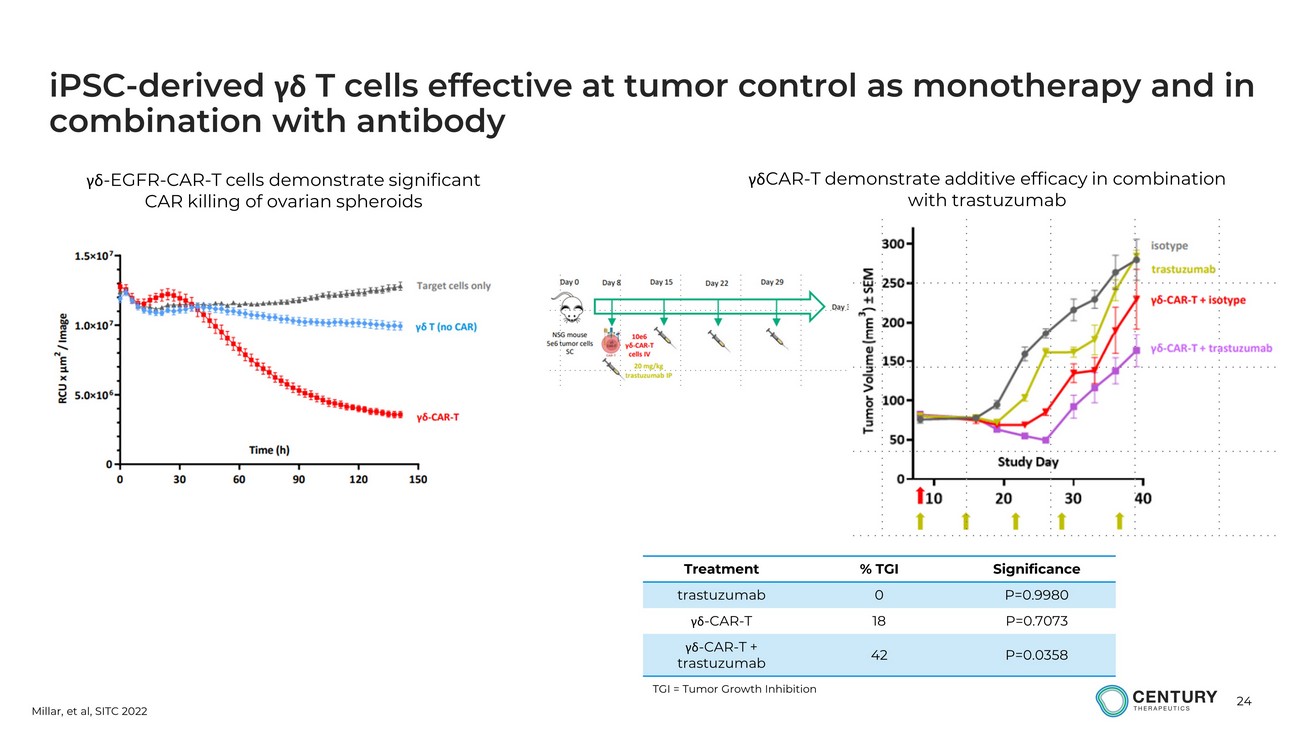
24 iPSC - derived γδ T cells effective at tumor control as monotherapy and in combination with antibody Millar, et al, SITC 2022 γδ - EGFR - CAR - T cells demonstrate significant CAR killing of ovarian spheroids γδ CAR - T demonstrate additive efficacy in combination with trastuzumab Treatment % TGI Significance trastuzumab 0 P=0.9980 γδ - CAR - T 18 P=0.7073 γδ - CAR - T + trastuzumab 42 P=0.0358 TGI = Tumor Growth Inhibition
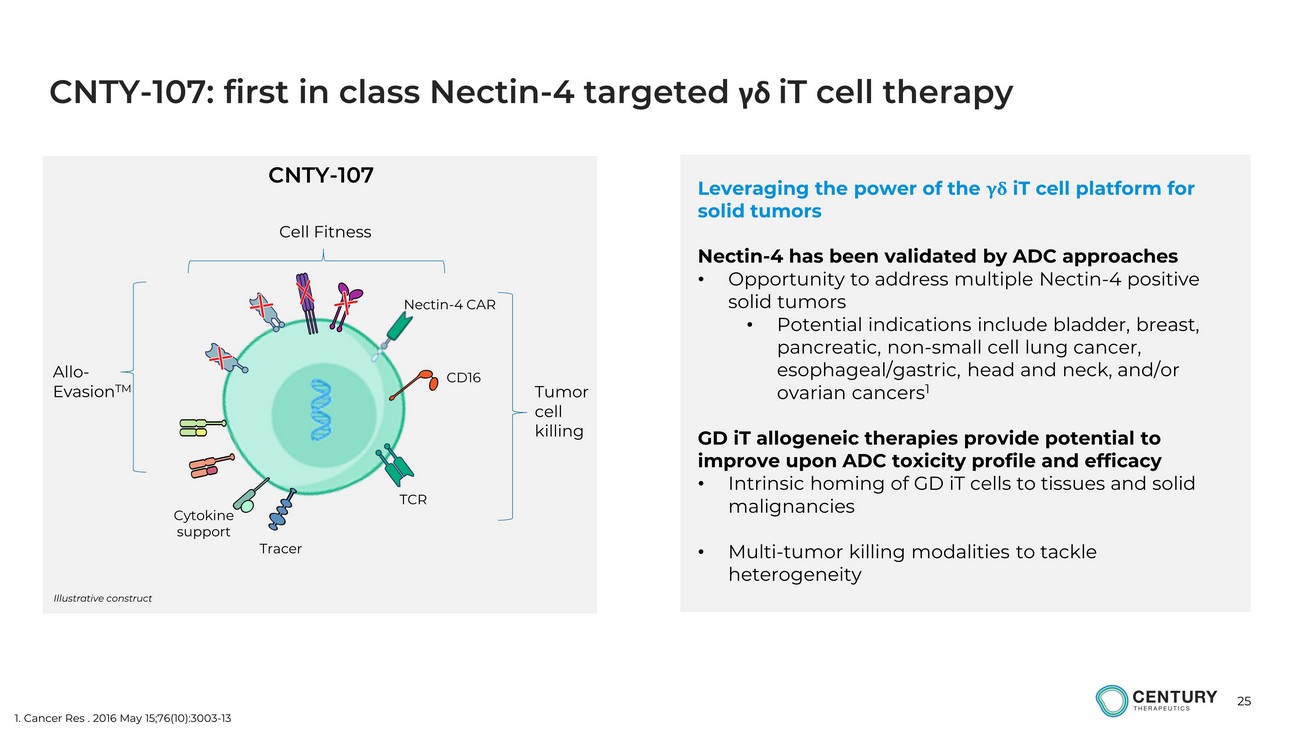
25 CNTY - 107: first in class Nectin - 4 targeted γδ iT cell therapy Leveraging the power of the γδ iT cell platform for solid tumors Nectin - 4 has been validated by ADC approaches • Opportunity to address multiple Nectin - 4 positive solid tumors • Potential indications include bladder, breast, pancreatic, non - small cell lung cancer, esophageal/gastric, head and neck, and/or ovarian cancers 1 GD iT allogeneic therapies provide potential to improve upon ADC toxicity profile and efficacy • Intrinsic homing of GD iT cells to tissues and solid malignancies • Multi - tumor killing modalities to tackle heterogeneity Tumor cell killing Allo - Evasion TM Cell Fitness CNTY - 107 Illustrative construct Nectin - 4 CAR CD16 Tracer TCR Cytokine support 1. Cancer Res . 2016 May 15;76(10):3003 - 13
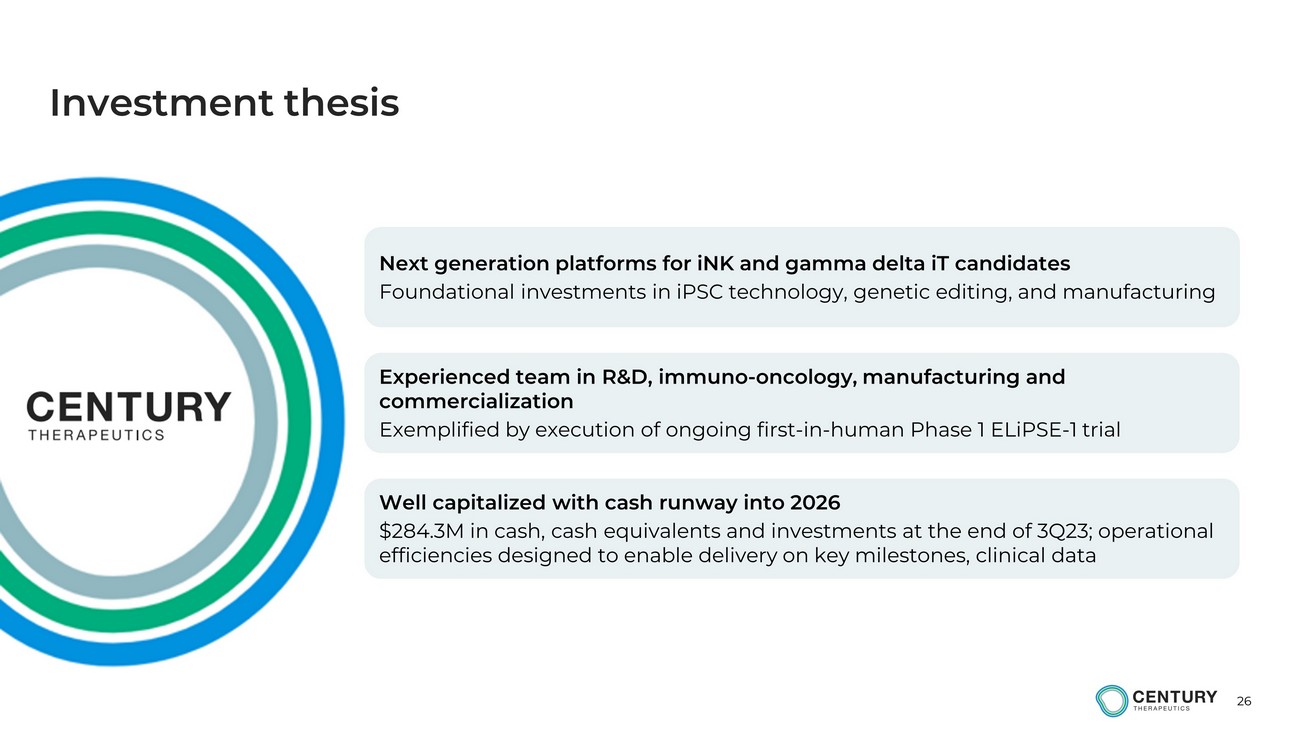
26 Investment thesis Next generation platforms for iNK and gamma delta iT candidates Foundational investments in iPSC technology, genetic editing, and manufacturing Experienced team in R&D, immuno - oncology, manufacturing and commercialization Exemplified by execution of ongoing first - in - human Phase 1 ELiPSE - 1 trial Well capitalized with cash runway into 2026 $284.3M in cash, cash equivalents and investments at the end of 3Q23; operational efficiencies designed to enable delivery on key milestones, clinical data
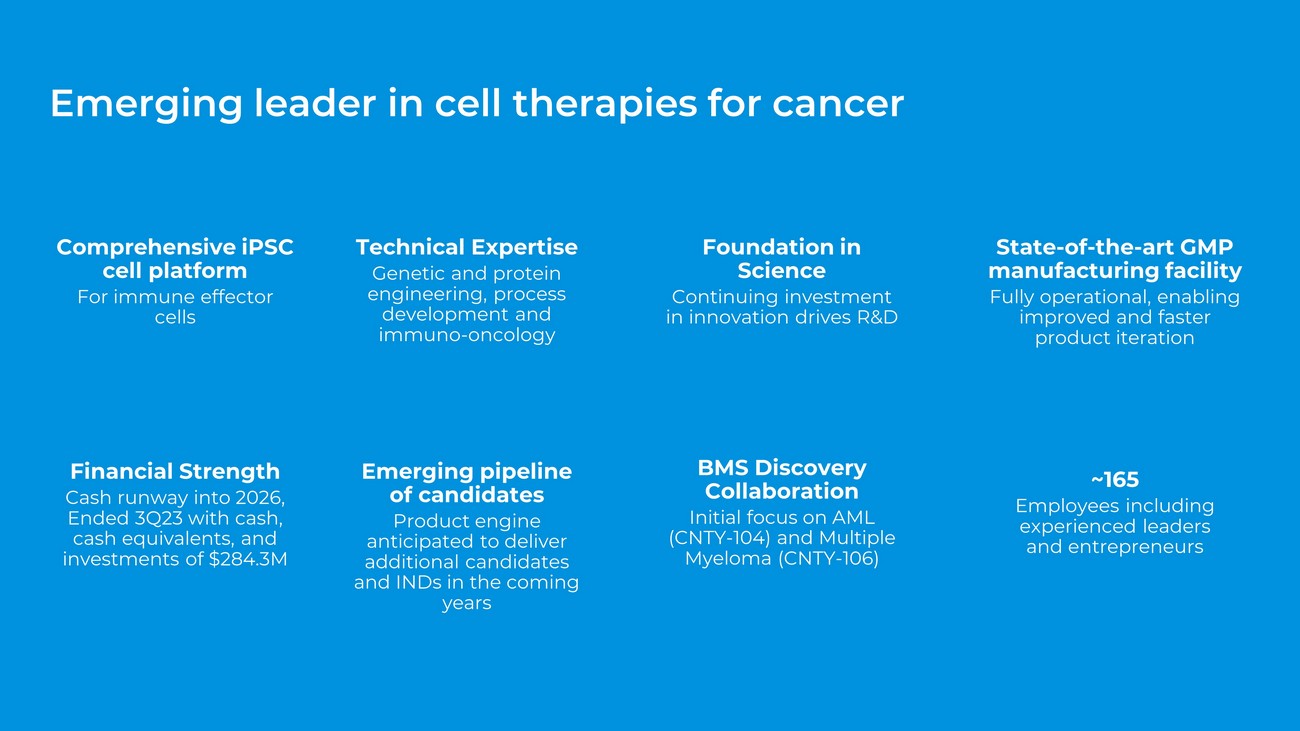
Emerging leader in cell therapies for cancer Comprehensive iPSC cell platform For immune effector cells Technical Expertise Genetic and protein engineering, process development and immuno - oncology Foundation in Science Continuing investment in innovation drives R&D State - of - the - art GMP manufacturing facility Fully operational, enabling improved and faster product iteration Financial Strength Cash runway into 2026, Ended 3Q23 with cash, cash equivalents, and investments of $284.3M ~ 165 Employees including experienced leaders and entrepreneurs Emerging pipeline of candidates Product engine anticipated to deliver additional candidates and INDs in the coming years BMS Discovery Collaboration Initial focus on AML (CNTY - 104) and Multiple Myeloma (CNTY - 106)
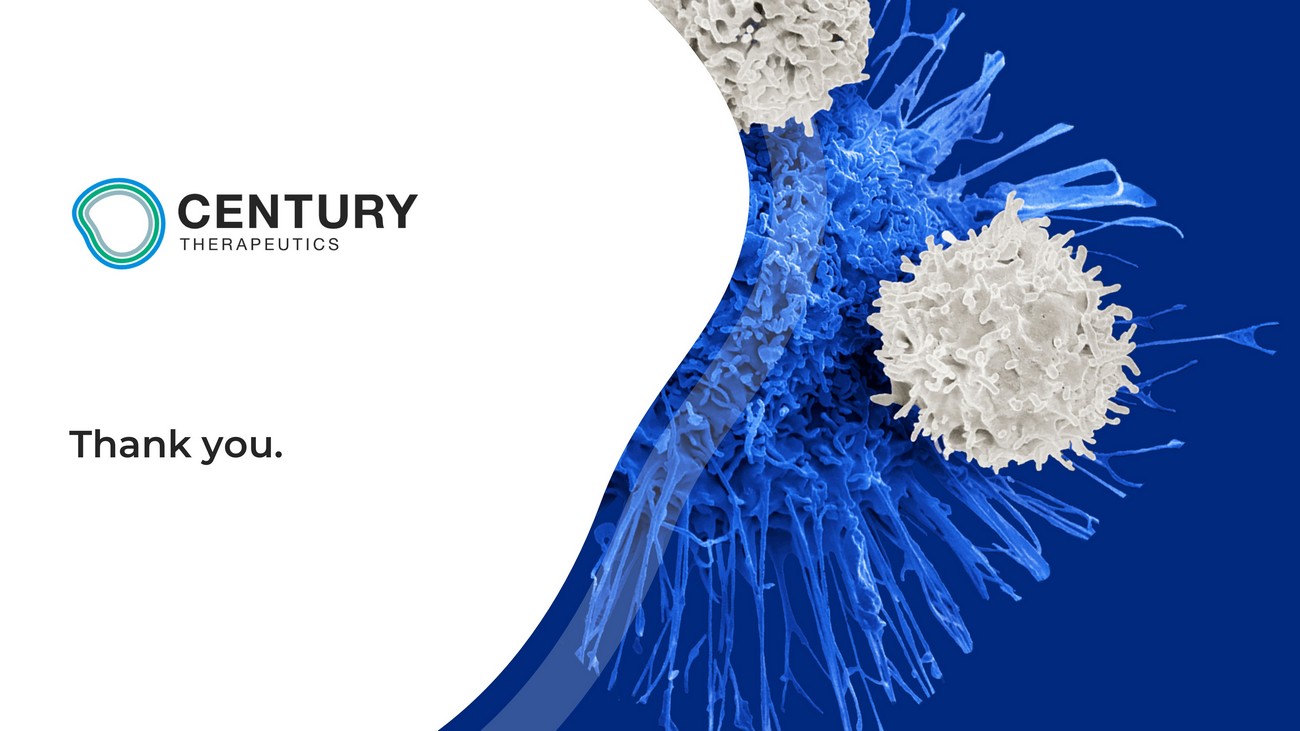
Thank you.



























